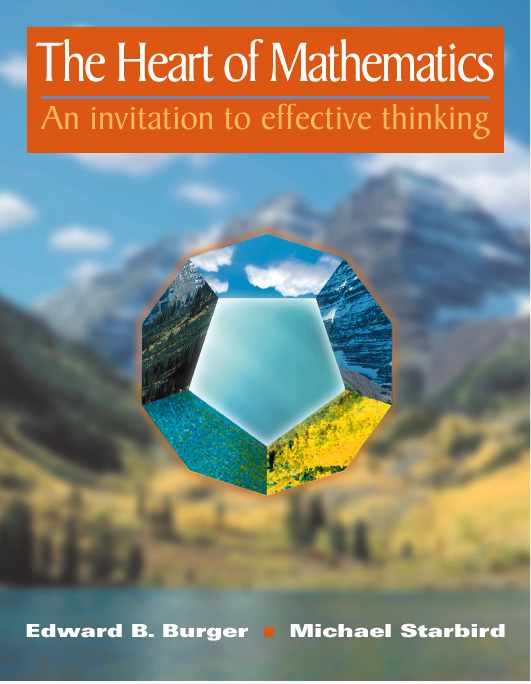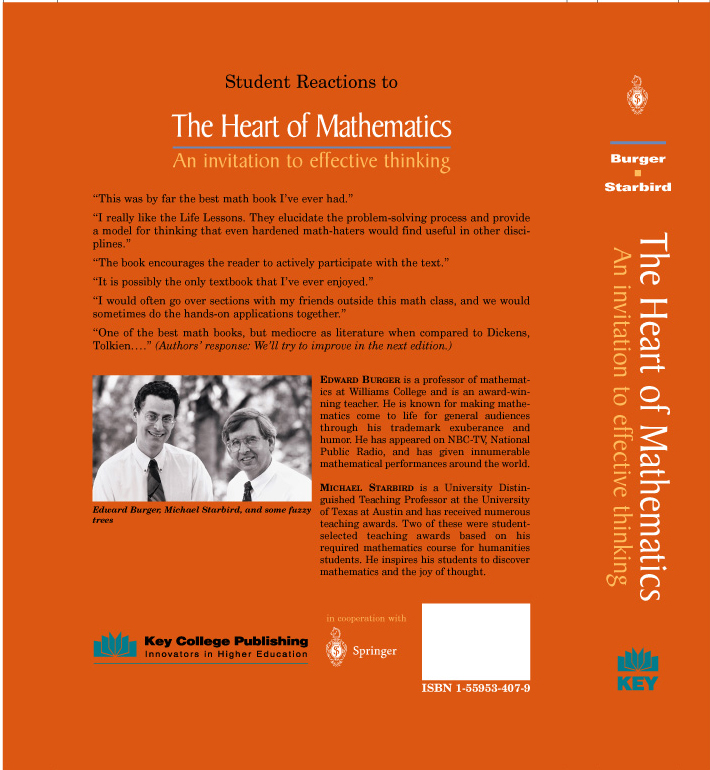Breaking news...
On June 10, 2002, The Heart of Mathematics: An invitation to effective thinking has an Amazon.com sales rank of 2,476 . The Heart of Mathematics: An invitation to effective thinking wins a 2001 Robert W. Hamilton Book Award ($3,000 Prize) on April 29, 2001. The Heart of Mathematics: An invitation to effective thinking is reviewed in The American Mathematical Monthly by Marion D. Cohen. Her review is available here. The Heart of Mathematics: An invitation to effective thinking is reviewed in The European Mathematical Society's Zentralblatt MATH. The review is available here. The Heart of Mathematics: An invitation to effective thinking is reviewed and highlighted in the article "El quehacer matematico, eficacia y belleza" by Miguel de Guzman in Saber Leer--Revista critica de libros Junio-Julio 2001, Madrid, Spain. Various reader reviews and sample pages can be viewed at amazon.com (but if you purchase the text through amazon, you will not receive the kit, 3D glasses, or CD-ROM).
The Heart of Mathematics: An invitation to effective thinkingentices readers to discover great ideas, powerful techniques of thinking, and a new worldview. The mathematical ideas explored in The Heart of Mathematicscompare in cultural significance to works of Shakespeare, Plato, and Michelangelo. Readers also learn lessons of effective thinking that have applications to their lives far beyond the mathematics. The accompanying kit includes hands-on puzzles, strange dice, materials for building geometric objects, 3D glasses to view the 3D pictures, and a CD-ROM. All these elements bring the mathematics to life and make the learning fun. The humor and the lively tone invite readers to read on; masterworks of art connect the mathematics with the broader culture; intriguing questions spark the imagination. The Heart of Mathematics: An invitation to effective thinkingopens eyes and opens minds.
The Heart of Mathematics: An invitation to effective thinkingwas an inspiration for Springer-Verlag to launch a new company dedicated to innovative, readable, and lively course materials---Key College Publishing. To order a copy or learn more about the text, visit The Heart of Mathematics web pages at www.heartofmath.com or at Springer-Verlag or call Key College at (888) 877-7240 or (510) 595-7000.
See the back cover (shown at the bottom of this page) for some student reactions to the text. Further information may also be obtained directly from by the authors: Edward Burger (Williams College) and Michael Starbird (The University of Texas at Austin).
Wonder how our book stacks up at The University of Texas at Austin? Click here!
The Heart of Mathematics: An invitation to effective thinking
Table of Contents
Welcome!
Surfing the book
Chapter 1---Fun and Games: An introduction to rigorous thought
1.1. Silly Stories All Having a Moral: Conundrums evoking techniques of effective thinking 1.2. Nudges: Leading questions and hints for resolving the stories 1.3. The Punch Lines: Solutions and further commentary 1.4. From Play to Power: Discovering strategies of thought for life Chapter 2---Number Contemplation
2.1. Counting: How the Pigeon Hole Principle leads to precision through estimation 2.2. Numerical Patterns in Nature: Discovering nature's beauty and the Fibonacci numbers 2.3. Prime Cuts of Numbers: How the prime numbers are the building blocks of all natural numbers 2.4. Crazy Clocks and Checking out Bars: Checking bar codes on products with cyclical clock arithmetic 2.5. Secret Codes and How to Become a Spy: How modular arithmetic and primes lead to secret public codes 2.6. The Irrational Side of Numbers: Are there numbers beyond fractions? 2.7. Get Real: The point of decimals and pinpointing numbers on the real line Chapter 3---Infinity
3.1. Beyond Numbers: What does infinity mean? 3.2. Comparing the Infinite: Pairing up collections via a one-to-one correspondence 3.3. The Missing Member: Georg Cantor answers: Are some infinities larger than others? 3.4. Travels Toward the Stratosphere of Infinities: The power set and the question of an infinite galaxy of infinities 3.5. Straightening Up the Circle: Exploring the infinite within geometrical objects Chapter 4---Geometric Gems
4.1. Pythagoras and his Hypotenuse: How a puzzle leads to the proof of one of the gems of mathematics 4.2. A View of an Art Gallery: Using computational geometry to place security cameras in museums 4.3. The Sexiest Rectangle: Finding aesthetics in life, art, and math through the Golden Rectangle 4.4. Soothing Symmetry and Spinning Pinwheels: Can the floor be tiled without any repeating pattern? 4.5. The Platonic Solids Turn Amorous: Discovering the symmetry and interconnections among the Platonic Solids 4.6. The Shape of Reality?: How straight lines can bend in non-Euclidean geometries 4.7. The Fourth Dimension: Can you see it? Chapter 5---Contortions of Space
5.1. Rubber Sheet Geometry: Discovering the topological idea of equivalence by distortion 5.2. The Band that Wouldn't Stop Playing: Experimenting with the Moebius Band and Klein Bottle 5.3. Feeling Edgy?: Exploring relationships among vertices, edges, and faces 5.4. Knots and Links: Untangling ropes and rings 5.5. Fixed Points, Hot Loops, and Rainy Days: How the certainty of fixed points implies certain weather phenomena Chapter 6---Chaos and Fractals
6.1. Images: Viewing a gallery of fractals 6.2. The Dynamics of Change: Can change be modeled by repeated applications of a simple process? 6.3. The Infinitely Detailed Beauty of Fractals: How to create works of infinite intricacy through repeated processes 6.4. The Mysterious Art of Imaginary Fractals: Creating Julia and Mandelbrot Sets by stepping out in the complex plane 6.5. Predetermined Chaos: How repeated simple processes result in utter chaos 6.6. Between Dimensions: Can the dimensions of fractals fall between the cracks? Chapter 7---Risky Business
7.1. Chance surprises: Some scenarios involving chance that confound our intuition 7.2. Predicting the Future in an Uncertain World: How to measure uncertainty through the idea of probability 7.3. Random thoughts: Are coincidences as truly amazing as they first appear? 7.4. Down for the count: Systematically counting all possible outcomes 7.5. Great Expectations: Weighing the unknown future through the notion of expected value 7.6. What the Average American Has: Peering into the pitfalls of statistics 7.7. Navigating Through a Sea of Data: How interpreting data reveals surprising and unintended results Farewell

The Cover: The mirrored-faced dodecahedron (a 12-sided regular solid) reflects how mathematics allows us to see and understand our world with greater clarity. It also illustrates how mathematics allows us to abstract nature and see the world in new ways. Finally, the mirrored-face in front reflects the power of mathematics to help us see ourselves with greater focus and fresh dimensions.

The Heart Of Mathematics 4th Edition Answers
Source: https://web.williams.edu/Mathematics/eburger/texts2.html
Posted by: bishoplonswellot.blogspot.com


0 Response to "The Heart Of Mathematics 4th Edition Answers"
Post a Comment